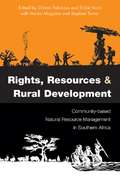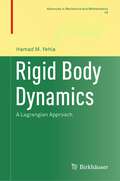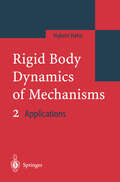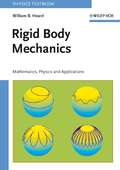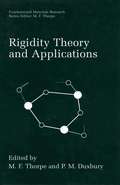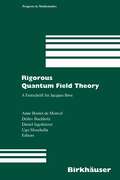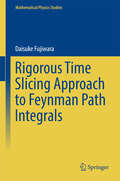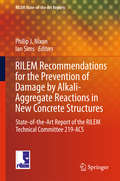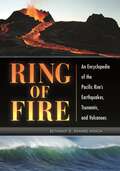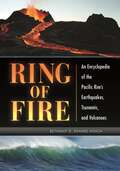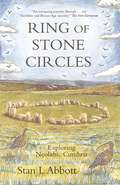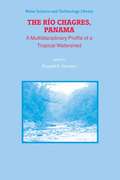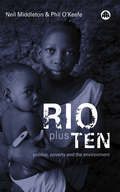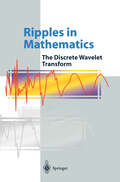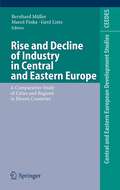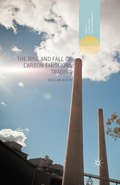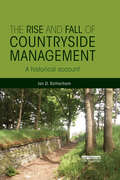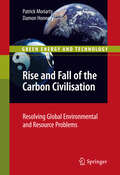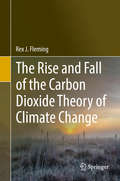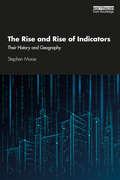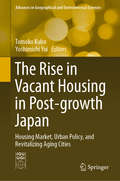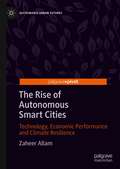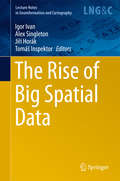- Table View
- List View
Rights Resources and Rural Development: Community-based Natural Resource Management in Southern Africa
by Christo Fabricius Eddie Koch Stephen Turner Hector MagomeCommunity-based natural resource management (CBNRM) is an approach that offers multiple related benefits: securing rural livelihoods; ensuring careful conservation and management of biodiversity and other resources; and empowering communities to manage these resources sustainably. Recently, however, the CBNRM concept has attracted criticism for failing in its promise of delivering significant local improvements and conserving biodiversity in some contexts. This book identifies the flaws in its application, which often have been swept under the carpet by those involved in the initiatives. The authors analyse them, and propose remedies for specific circumstances based on the lessons learned from CBNRM experience in southern Africa over more than a decade. The result is essential reading for all researchers, observers and practitioners who have focused on CBNRM in sustainable development programmes as a means to overcome poverty and conserve ecosystems in various parts of the globe. It is a vital tool in improving their methods and performance. In addition, academics, students and policy-makers in natural resource management, resource economics, resource governance and rural development will find it a very valuable and instructive resource.
Rigid Body Dynamics: A Lagrangian Approach (Advances in Mechanics and Mathematics #45)
by Hamad M. YehiaThis monograph provides a complete and up-to-date examination of rigid body dynamics using a Lagrangian approach. All known integrable cases, which were previously scattered throughout the literature, are collected here for convenient reference. Also contained are particular solutions to diverse problems treated within rigid body dynamics. The first seven chapters introduce the elementary dynamics of the rigid body and its main problems. A full historical account of the discovery and development of each of the integrable cases is included as well. Instructors will find this portion of the book well-suited for an undergraduate course, having been formulated by the author in the classroom over many years. The second part includes more advanced topics and some of the author’s original research, highlighting several unique methods he developed that have led to significant results. Some of the specific topics covered include the twelve known solutions of the equations of motion in the classical problem, which has not previously appeared in English before; a collection of completely new integrable cases; and the motion of a rigid body around a fixed point under the action of an asymmetric combination of potential and gyroscopic forces. Rigid Body Dynamics will appeal to researchers in the area as well as those studying dynamical and integrable systems theory.
Rigid Body Dynamics of Mechanisms 2: Applications
by Hubert HahnIntended for self-study, this second volume presents a systematic approach for deriving model equations of planar and spatial mechanisms. The necessary theoretical foundations have been laid in the first volume. The focus is on the application of the modeling methodology to various examples of rigid-body mechanisms, simple planar ones as well as more challenging spatial problems. A rich variety of joint models, active constraints, as well as active and passive force elements is treated. The book is intended for self-study by working engineers and students concerned with the control of mechanical systems, i.e. robotics, mechatronics, vehicles, and machine tools. Its examples can be used as models for university lectures.
Rigid Body Mechanics: Mathematics, Physics and Applications
by William B. HeardThis textbook is a modern, concise and focused treatment of the mathematical techniques, physical theories and applications of rigid body mechanics, bridging the gap between the geometric and more classical approaches to the topic. It emphasizes the fundamentals of the subject, stresses the importance of notation, integrates the modern geometric view of mechanics and offers a wide variety of examples -- ranging from molecular dynamics to mechanics of robots and planetary rotational dynamics. The author has unified his presentation such that applied mathematicians, mechanical and astro-aerodynamical engineers, physicists, computer scientists and astronomers can all meet the subject on common ground, despite their diverse applications. * Free solutions manual available for lecturers at www.wiley-vch.de/supplements/
Rigidity Theory and Applications (Fundamental Materials Research)
by M. F. Thorpe P. M. DuxburyAlthough rigidity has been studied since the time of Lagrange (1788) and Maxwell (1864), it is only in the last twenty-five years that it has begun to find applications in the basic sciences. The modern era starts with Laman (1970), who made the subject rigorous in two dimensions, followed by the development of computer algorithms that can test over a million sites in seconds and find the rigid regions, and the associated pivots, leading to many applications. This workshop was organized to bring together leading researchers studying the underlying theory, and to explore the various areas of science where applications of these ideas are being implemented.
Rigorous Quantum Field Theory: A Festschrift for Jacques Bros (Progress in Mathematics #251)
by Anne Boutet De Monvel Detlev Buchholz Daniel Iagolnitzer Ugo MoschellaJacques Bros has greatly advanced our present understanding of rigorous quantum field theory through numerous contributions; this book arose from an international symposium held in honour of Bros on the occasion of his 70th birthday. Key topics in this volume include: Analytic structures of Quantum Field Theory (QFT), renormalization group methods, gauge QFT, stability properties and extension of the axiomatic framework, QFT on models of curved spacetimes, QFT on noncommutative Minkowski spacetime.
Rigorous Time Slicing Approach to Feynman Path Integrals (Mathematical Physics Studies)
by Daisuke FujiwaraThis book proves that Feynman's original definition of the path integral actually converges to the fundamental solution of the Schrödinger equation at least in the short term if the potential is differentiable sufficiently many times and its derivatives of order equal to or higher than two are bounded. The semi-classical asymptotic formula up to the second term of the fundamental solution is also proved by a method different from that of Birkhoff. A bound of the remainder term is also proved.The Feynman path integral is a method of quantization using the Lagrangian function, whereas Schrödinger's quantization uses the Hamiltonian function. These two methods are believed to be equivalent. But equivalence is not fully proved mathematically, because, compared with Schrödinger's method, there is still much to be done concerning rigorous mathematical treatment of Feynman's method. Feynman himself defined a path integral as the limit of a sequence of integrals over finite-dimensional spaces which is obtained by dividing the time interval into small pieces. This method is called the time slicing approximation method or the time slicing method.This book consists of two parts. Part I is the main part. The time slicing method is performed step by step in detail in Part I. The time interval is divided into small pieces. Corresponding to each division a finite-dimensional integral is constructed following Feynman's famous paper. This finite-dimensional integral is not absolutely convergent. Owing to the assumption of the potential, it is an oscillatory integral. The oscillatory integral techniques developed in the theory of partial differential equations are applied to it. It turns out that the finite-dimensional integral gives a finite definite value. The stationary phase method is applied to it. Basic properties of oscillatory integrals and the stationary phase method are explained in the book in detail.Those finite-dimensional integrals form a sequence of approximation of the Feynman path integral when the division goes finer and finer. A careful discussion is required to prove the convergence of the approximate sequence as the length of each of the small subintervals tends to 0. For that purpose the book uses the stationary phase method of oscillatory integrals over a space of large dimension, of which the detailed proof is given in Part II of the book. By virtue of this method, the approximate sequence converges to the limit. This proves that the Feynman path integral converges. It turns out that the convergence occurs in a very strong topology. The fact that the limit is the fundamental solution of the Schrödinger equation is proved also by the stationary phase method. The semi-classical asymptotic formula naturally follows from the above discussion.A prerequisite for readers of this book is standard knowledge of functional analysis. Mathematical techniques required here are explained and proved from scratch in Part II, which occupies a large part of the book, because they are considerably different from techniques usually used in treating the Schrödinger equation.
RILEM Recommendations for the Prevention of Damage by Alkali-Aggregate Reactions in New Concrete Structures: State-of-the-Art Report of the RILEM Technical Committee 219-ACS (RILEM State-of-the-Art Reports #17)
by Philip J. Nixon Ian SimsThis book contains the full set of RILEM Recommendations which have been produced to enable engineers, specifiers and testing houses to design and produce concrete which will not suffer damage arising from alkali reactions in the concrete. There are five recommended test methods for aggregates (designated AAR-1 to AAR-5), and an overall recommendation which describes how these should be used to enable a comprehensive aggregate assessment (AAR-0). Additionally, there are two Recommended International Specifications for concrete (AAR-7.1 & 7.2) and a Preliminary International Specification for dams and other hydro structures (AAR-7.3), which describe how the aggregate assessment can be combined with other measures in the design of the concrete to produce a concrete with a minimised risk of developing damage from alkali-aggregate reactions.
Ring of Fire: An Encyclopedia of the Pacific Rim's Earthquakes, Tsunamis, and Volcanoes
by Bethany D. HingaThe author examines natural disasters around the Pacific Rim throughout history together with scientific data context to produce enlightening—and highly readable—entries.On March 11, 2011, a magnitude 9.0 earthquake struck off Japan's coast, triggering a powerful tsunami. The massive destruction that resulted proved that not even sophisticated, industrialized nations are immune from nature's fury. Written to take some of the mystery out of the earth's behavior, this encyclopedia chronicles major natural disasters that have occurred around the Pacific Rim, an area nicknamed the "Ring of Fire" because of the volatile earth that lies above and below. The encyclopedia offers descriptions of deadly earthquakes, volcanic eruptions, and tsunamis through time. The entries provide in-depth information that promotes an understanding of the structure of the earth and earth processes and shares the insights of scientists whose work helps clarify the causes and effects of these cataclysmic events. At the same time, the work examines how the people and cultures of the Pacific Rim view this active part of the earth, how they live with the threat of disaster, and how they have been affected by major events that have occurred. Readers will come away with a holistic view of what is known, how this knowledge was gained, and what its implications may be.
Ring of Fire: An Encyclopedia of the Pacific Rim's Earthquakes, Tsunamis, and Volcanoes
by Bethany D. HingaThe author examines natural disasters around the Pacific Rim throughout history together with scientific data context to produce enlightening—and highly readable—entries.On March 11, 2011, a magnitude 9.0 earthquake struck off Japan's coast, triggering a powerful tsunami. The massive destruction that resulted proved that not even sophisticated, industrialized nations are immune from nature's fury. Written to take some of the mystery out of the earth's behavior, this encyclopedia chronicles major natural disasters that have occurred around the Pacific Rim, an area nicknamed the "Ring of Fire" because of the volatile earth that lies above and below. The encyclopedia offers descriptions of deadly earthquakes, volcanic eruptions, and tsunamis through time. The entries provide in-depth information that promotes an understanding of the structure of the earth and earth processes and shares the insights of scientists whose work helps clarify the causes and effects of these cataclysmic events. At the same time, the work examines how the people and cultures of the Pacific Rim view this active part of the earth, how they live with the threat of disaster, and how they have been affected by major events that have occurred. Readers will come away with a holistic view of what is known, how this knowledge was gained, and what its implications may be.
Ring of Stone Circles: Exploring Neolithic Cumbria
by Stan L AbbottTo paraphrase L.P. Hartley, “The past is a different country.” Stan L Abbott sets out to explore the visible clues to our mysterious past from the Neolithic and Bronze Ages: stone circles. Cumbria boasts more of these monuments than any other English county. Here, our tallest mountains are ringed by almost fifty circles and henges, most of them sited in the foothills or on outlying plateaux. Were these the earliest such monuments in Britain, placing Cumbria at the heart of Neolithic society? And what traces of that society remain today in the roads we travel, the food we eat, the words we speak, our work and play? By observing and comparing many sites in Cumbria and beyond, and researching many sources, a greater understanding emerges. Were some circles built for ritualistic purposes, or perhaps astronomical? Were they burial sites? Or were they just places for people to meet? Illustrated with linocut illustrations by artist Denise Burden, Ring of Stone Circles follows the search for the hidden stories these monuments guard – and might reveal if we get to know them.
The Rio Chagres, Panama: A Multidisciplinary Profile of a Tropical Watershed (Water Science and Technology Library #52)
by Russell S. HarmonThis book examines one of the most important and complex of the world's tropical rainforest regions: the greater Panama Canal Watershed. The Rio Chagres is the primary water source for operating the Canal, and supplies potable water for municipal use and electricity generation, but science has left this important national resource largely unstudied. The text promotes understanding of the physical and ecological components of an isolated and largely pristine tropical rainforest.
Rio Plus Ten: Politics, Poverty and the Environment
by Neil Middleton Phil OKeefeThe World Summit on Sustainable Development took place in Johannesburg, South Africa in September 2002. In this book, the authors look at the agenda established since the original Rio conference in 1992 and cover the events of the intervening years: global warming and the unfolding arguments over climate change, energy, water and sanitation, patents and many other issues. They examine what progress, if any, has been made. *BR**BR*Offering a critical analysis of the links between neoliberal economics and transnational organisations, the authors expose the poverty of so-called international protocols and resolutions which claim to offer solutions. *BR**BR*They show how, in virtually every case, these resolutions remain part of the problem of continuing poverty and environmental degradation in the non-Western world.
Ripples in Mathematics: The Discrete Wavelet Transform
by A. Jensen Anders la Cour-HarboThis introduction to the discrete wavelet transform and its applications is based on a novel approach to discrete wavelets called lifting. After an elementary introduction, connections of filter theory are presented, and wavelet packet transforms are defined. The time-frequency plane is used for interpretation of signals, problems with finite length signals are detailed, and MATLAB is used for examples and implementation of transforms.
Rise and Decline of Industry in Central and Eastern Europe: A Comparative Study of Cities and Regions in Eleven Countries (Central and Eastern European Development Studies (CEEDES))
by Bernhard Müller Maros Finka Gerd LintzIn the course of the tremendous political and economic upheaval starting in 1989/1990 many industrial cities and regions in Central and Eastern Europe have been confronted with profound problems. This book presents eleven detailed national reports which describe the situation in such cities and regions as well as the strategies which have been employed to cope with structural change. The country reports are complemented by short case studies of selected cities and regions. An introduction gives background to such topics as structural change and the ramifications of EU enlargement. Finally some conclusions are drawn and recommendations offered for future policy.
The Rise and Fall of Carbon Emissions Trading (Energy, Climate and the Environment)
by Declan KuchThis book presents the results of the first full-scale emissions trading schemes in Australia and internationally, arguing these schemes will not be sufficient to 'civilize markets' and prevent dangerous climate change. Instead, it articulates the ways climate policy needs to confront the collective nature of our predicament.
The Rise and Fall of Countryside Management: A Historical Account
by Ian D. RotherhamFor at least half a century since the emergence of Country Parks and Forest Parks, countryside services have provided leisure, tourism, conservation, restoration and regeneration across Britain. Yet these services are currently being decimated as public services are sacrificed to the new era of austerity. The role and importance of countryside management have been barely documented, and the consequences and ramifications of cuts to these services are overlooked and misunderstood. This volume rigorously examines the issues surrounding countryside management in Britain. The author brings together the results of stakeholder workshops and interviews, and in-depth individual case studies, as well as a major study for the Countryside Agency which assessed and evaluated every countryside service provision in England. A full and extensive literature review traces the ideas of countryside management back to their origins, and the author considers the wider relationships and ramifications with countryside and ranger provisions around the world, including North America and Europe. The book provides a critical overview of the history and importance of countryside management, detailing the achievements of a largely forgotten sector and highlighting its pivotal yet often underappreciated role in the wellbeing of people and communities. It serves as a challenge to students, planners, politicians, conservationists, environmentalists, and land managers, in a diversity of disciplines that work with or have interests in countryside, leisure and tourism, community issues, education, and nature conservation.
The Rise and Fall of Countryside Management: A Historical Account
by Ian D. RotherhamFor at least half a century since the emergence of Country Parks and Forest Parks, countryside services have provided leisure, tourism, conservation, restoration and regeneration across Britain. Yet these services are currently being decimated as public services are sacrificed to the new era of austerity. The role and importance of countryside management have been barely documented, and the consequences and ramifications of cuts to these services are overlooked and misunderstood. This volume rigorously examines the issues surrounding countryside management in Britain. The author brings together the results of stakeholder workshops and interviews, and in-depth individual case studies, as well as a major study for the Countryside Agency which assessed and evaluated every countryside service provision in England. A full and extensive literature review traces the ideas of countryside management back to their origins, and the author considers the wider relationships and ramifications with countryside and ranger provisions around the world, including North America and Europe. The book provides a critical overview of the history and importance of countryside management, detailing the achievements of a largely forgotten sector and highlighting its pivotal yet often underappreciated role in the wellbeing of people and communities. It serves as a challenge to students, planners, politicians, conservationists, environmentalists, and land managers, in a diversity of disciplines that work with or have interests in countryside, leisure and tourism, community issues, education, and nature conservation.
Rise and Fall of the Carbon Civilisation: Resolving Global Environmental and Resource Problems (Green Energy and Technology)
by Patrick Moriarty Damon HonneryA vast amount has been written on climate change and what should be our response. Rise and Fall of the Carbon Civilisation suggests that most of this literature takes a far too optimistic position regarding the potential for conventional mitigation solutions to achieve the deep cuts in greenhouse gases necessary in the limited time frame we have available. In addition, global environmental problems, as exemplified by climate change, and global resource problems – such as fossil fuel depletion or fresh water scarcity – have largely been seen as separate issues. Further, proposals for solution of these problems often focus at the national level, when the problems are global. The authors argue that the various challenges the planet faces are both serious and interconnected. Rise and Fall of the Carbon Civilisation takes a global perspective in its treatment of various solutions: • renewable energy; • nuclear energy; • energy efficiency; • carbon sequestration; and • geo-engineering. It also addresses the possibility that realistic solutions cannot be achieved until the fundamentally ethical question of global equity – both across nations today and also inter-generational – is fully addressed. Such an approach will also involve reorienting the global economy away from an emphasis on growth and toward the direct satisfaction of basic human needs for all the Earth’s people. Rise and Fall of the Carbon Civilisation is aimed at the many members of the public with an awareness of climate change, but who wish to find out more about how we need to respond to the challenge. It will also be of interest to technical professionals, as well as postgraduate students and researchers, from the environmental and engineering science sectors.
The Rise and Fall of the Carbon Dioxide Theory of Climate Change
by Rex J. FlemingThis book provides a complete review of the role of CO2 in the Earth’s atmosphere and reveals detailed information about the subject of climate change. Many different science disciplines are visited and discussed and each area is introduced with a brief summary written to appeal to a broader audience. The logic of CO2 involvement in changing the climate is investigated from every perspective: reviewing the historical data record of Ice Ages with vast ice sheets, noting the interglacial periods of little or no ice, examining in further detail the 20th century data record and evaluating the radiation role of CO2 in the atmosphere. The radiation calculations, using the appropriate equations and data are reviewed in great detail. The results of this review and examination reveal no role of CO2 in any change of the Earth’s climate. Disclaimer: The views expressed in this book belong solely to the author.
The Rise and Rise of Indicators: Their History and Geography
by Stephen MorseThis book makes indicators more accessible, in terms of what they are, who created them and how they are used. It examines the subjectivity and human frailty behind these quintessentially ‘hard’ and technical measures of the world. To achieve this goal, The Rise and Rise of Indicators presents the world in terms of a selected set of indicators. The emphasis is upon the origins of the indicators and the motivation behind their creation and evolution. The ideas and assumptions behind the indicators are made transparent to demonstrate how changes to them can dramatically alter the ranking of countries that emerge. They are, after all, human constructs and thus embody human biases. The book concludes by examining the future of indicators and the author sets out some possible trajectories, including the growing emphasis on indicators as important tools in the Sustainable Development Goals that have been set for the world up until 2030. This is a valuable resource for undergraduate and postgraduate students in the areas of economics, sociology, geography, environmental studies, development studies, area studies, business studies, politics and international relations.
The Rise and Rise of Indicators: Their History and Geography
by Stephen MorseThis book makes indicators more accessible, in terms of what they are, who created them and how they are used. It examines the subjectivity and human frailty behind these quintessentially ‘hard’ and technical measures of the world. To achieve this goal, The Rise and Rise of Indicators presents the world in terms of a selected set of indicators. The emphasis is upon the origins of the indicators and the motivation behind their creation and evolution. The ideas and assumptions behind the indicators are made transparent to demonstrate how changes to them can dramatically alter the ranking of countries that emerge. They are, after all, human constructs and thus embody human biases. The book concludes by examining the future of indicators and the author sets out some possible trajectories, including the growing emphasis on indicators as important tools in the Sustainable Development Goals that have been set for the world up until 2030. This is a valuable resource for undergraduate and postgraduate students in the areas of economics, sociology, geography, environmental studies, development studies, area studies, business studies, politics and international relations.
The Rise in Vacant Housing in Post-growth Japan: Housing Market, Urban Policy, and Revitalizing Aging Cities (Advances in Geographical and Environmental Sciences)
by Tomoko Kubo Yoshimichi YuiThis book explores how Japanese cities have transformed since the 1950s by describing housing and urban planning policies, urbanization processes, and maps with GIS analysis. It also discusses how housing vacancies have increased in shrinking Japanese cities, with case studies in Tokyo, Kyoto, Hiroshima, and Utsunomiya, and examines public–private partnerships and civil engagement to revitalize cities. Providing examples of how Japanese cities have addressed the issues of aging populations and urban shrinkage, it contributes to better decision-making by politicians, planners, local authorities, NPOs, and local communities in many rapidly urbanizing and potentially aging regions such as Asia.In the era of urban shrinkage, Japanese cities have struggled with aging populations, low fertility, population loss, and a decline in the economic base over decades. In particular, shrinkage in metropolitan suburbs and large cities (e.g., sites of prefectural government with 300 000–400 000 inhabitants) has caused serious social problems owing to the huge aging population and large areas covered. One typical problem that has emerged is an increase in vacancies in now empty and abandoned housing.
The Rise of Autonomous Smart Cities: Technology, Economic Performance and Climate Resilience (Sustainable Urban Futures)
by Zaheer AllamThis book introduces the concept of the ‘autonomous city’- a concept that has been developed from the ‘smart cities’ model that is based on a city’s ability to gather data and taking it one step further. The digital revolution has brought about numerous changes in the urban realm, along with the understanding that technology can aid in increasing the performance and efficiency of urban areas. This technology has given rise to a wealth of data allowing urban leaders to respond better to crisis and craft policies that increase the liveability of urban areas. The ‘autonomous city’ explores the possibility of urban areas evolving from the dimension of data gathering to that of action response – so a city able to collect data and render real time decisions to self-manage a variety of functions based on its interpretation of that data. The book discusses how this could lead to the automation of select urban dimensions for increased efficiency and performance, but also details how such a process would require careful consideration when put into practice. This book will be a valuable resource for scholars and students across Urban Planning, Sustainability and STS, as well as practitioners and policy makers involved in the development of urban life.
The Rise of Big Spatial Data (Lecture Notes in Geoinformation and Cartography)
by Igor Ivan Alex Singleton Jiří Horák Tomáš InspektorThis edited volume gathers the proceedings of the Symposium GIS Ostrava 2016, the Rise of Big Spatial Data, held at the Technical University of Ostrava, Czech Republic, March 16–18, 2016. Combining theoretical papers and applications by authors from around the globe, it summarises the latest research findings in the area of big spatial data and key problems related to its utilisation.Welcome to dawn of the big data era: though it’s in sight, it isn’t quite here yet. Big spatial data is characterised by three main features: volume beyond the limit of usual geo-processing, velocity higher than that available using conventional processes, and variety, combining more diverse geodata sources than usual. The popular term denotes a situation in which one or more of these key properties reaches a point at which traditional methods for geodata collection, storage, processing, control, analysis, modelling, validation and visualisation fail to provide effective solutions. >Entering the era of big spatial data calls for finding solutions that address all “small data” issues that soon create “big data” troubles. Resilience for big spatial data means solving the heterogeneity of spatial data sources (in topics, purpose, completeness, guarantee, licensing, coverage etc.), large volumes (from gigabytes to terabytes and more), undue complexity of geo-applications and systems (i.e. combination of standalone applications with web services, mobile platforms and sensor networks), neglected automation of geodata preparation (i.e. harmonisation, fusion), insufficient control of geodata collection and distribution processes (i.e. scarcity and poor quality of metadata and metadata systems), limited analytical tool capacity (i.e. domination of traditional causal-driven analysis), low visual system performance, inefficient knowledge-discovery techniques (for transformation of vast amounts of information into tiny and essential outputs) and much more. These trends are accelerating as sensors become more ubiquitous around the world.
